
States with the highest and lowest Trump approval ratings
States with the highest and lowest Trump approval ratings
Donald Trump's popularity with everyday Americans has been newsworthy since before he was sworn into office. At the start of his term, Trump had the lowest approval rating of any incoming president since numbers were first collected. Complicating Trump's approval rating throughout his term is the fact that his presidency—whether you approve of the president or not—has been fraught from the get-go.
Trump's controversial tenure has included the longest government shutdown in U.S. history, an investigation into collusion with the Russian government in the lead-up to the 2016 election, impeachment hearings, and now a pandemic that has killed more Americans in a few months than died in the Vietnam War. He's also presided over some stunning highs; including the lowest unemployment numbers in a half-century, the highest-recorded median household income, and his enormous impact on the federal judiciary.
His fans and detractors fall largely along geographic lines. States in the South and Midwest with a large number of white, rural, and Christian voters support Trump, while coastal states with big cities and more people of color, millennials, and college grads tend to have less favorable views. Similarly, Trump's approval mostly falls along party lines. For three years in a row, Trump set a record for partisan approval gaps between Republicans and Democrats; in January 2020, Gallup measured that gap at 82 percentage points: 89% approval by Republicans, 7% approval by Democrats.
Trump's handling of the novel coronavirus pandemic caused his approval ratings to suffer their sharpest drop of his presidency, according to a Gallup poll conducted from April 1 to 14 showing a 43% approval and 54% disapproval rating. The numbers represent a six-point decline from the poll prior.
To get a better grasp of Trump's popularity by state, Stacker mined data from an extensive presidential-ratings survey and up-to-date information about testing in each state. The first of those sources is The State of the Nation: A 50-state COVID-19 Survey, conducted by PureSpectrum from April 17 to 26, 2020, to include 22,912 individuals across all 50 states plus the District of Columbia. The survey was conducted via an online, nonprobability sample with state-level representative quotas for race/ethnicity, age, and gender.
The second data source considered was The COVID Tracking Project, housed at the Atlantic, which publishes up-to-date testing data (latest data and data release date: May 1, 2020). All of the information, updated daily by 5 p.m. ET, comes from state, district, and territory public health authorities, official press releases, trusted news reporting, and (infrequently) tweets or Facebook posts from state public health authorities or governors.
In the forthcoming gallery, states are ranked by the number of respondents who approve or strongly approve of how President Donald Trump has responded to COVID-19. Ties are broken by how many respondents trust Trump to handle COVID-19. Read on to see how your state feels about the president and which states in the South and Midwest will be the places to watch during Trump's 2020 re-election campaign.
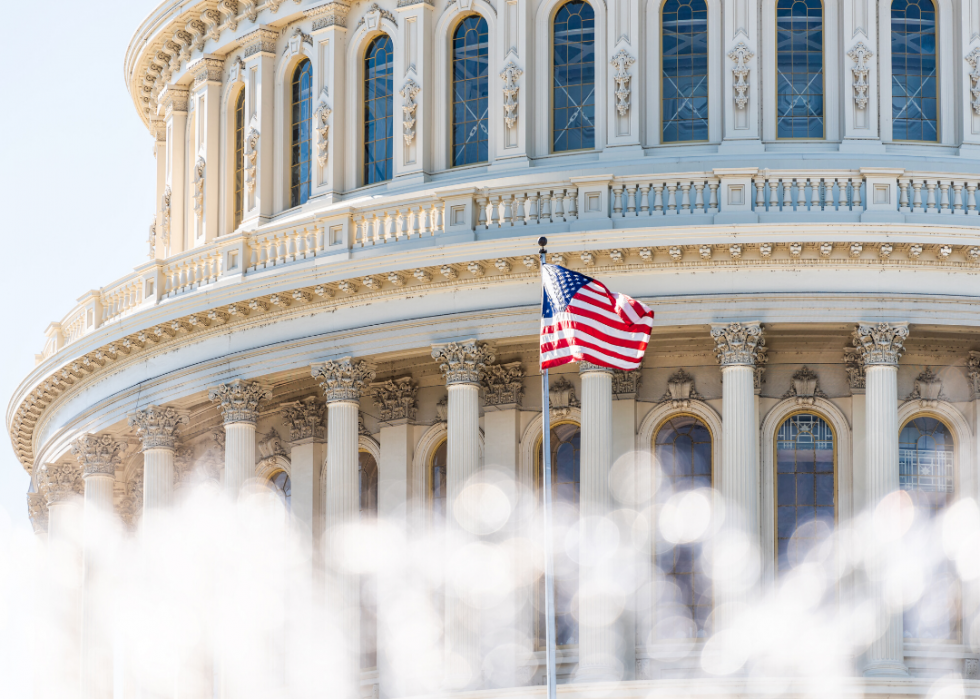
#51. Washington D.C.
- Respondents on Trump's handling of the response to COVID-19:
--- Approve or strongly approve: 28%
--- Neither approve nor disapprove: 18%
--- Disapprove or strongly disapprove: 53%
- Respondents on trusting Trump to handle COVID-19 response:
--- Trust Trump a lot: 27%
--- Don't trust Trump at all: 40%
- Party of respondents:
--- Republican: 16%
--- Democrat: 66%
--- Independent: 17%
--- Other: 2%
- State COVID-19 statistics as of May 1:
--- Positive cases: 4,658
--- Cumulative hospitalizations: data not available
--- Death toll: 231

#50. Vermont
- Respondents on Trump's handling of the response to COVID-19:
--- Approve or strongly approve: 32%
--- Neither approve nor disapprove: 15%
--- Disapprove or strongly disapprove: 53%
- Respondents on trusting Trump to handle COVID-19 response:
--- Trust Trump a lot: 11%
--- Don't trust Trump at all: 44%
- Party of respondents:
--- Republican: 24%
--- Democrat: 29%
--- Independent: 41%
--- Other: 6%
- State COVID-19 statistics as of May 1:
--- Positive cases: 879
--- Cumulative hospitalizations: data not available
--- Death toll: 50

#49. Hawaii
- Respondents on Trump's handling of the response to COVID-19:
--- Approve or strongly approve: 32%
--- Neither approve nor disapprove: 24%
--- Disapprove or strongly disapprove: 44%
- Respondents on trusting Trump to handle COVID-19 response:
--- Trust Trump a lot: 17%
--- Don't trust Trump at all: 37%
- Party of respondents:
--- Republican: 20%
--- Democrat: 37%
--- Independent: 31%
--- Other: 12%
- State COVID-19 statistics as of May 1:
--- Positive cases: 618
--- Cumulative hospitalizations: 70
--- Death toll: 16

#48. Oregon
- Respondents on Trump's handling of the response to COVID-19:
--- Approve or strongly approve: 34%
--- Neither approve nor disapprove: 14%
--- Disapprove or strongly disapprove: 53%
- Respondents on trusting Trump to handle COVID-19 response:
--- Trust Trump a lot: 17%
--- Don't trust Trump at all: 44%
- Party of respondents:
--- Republican: 27%
--- Democrat: 42%
--- Independent: 25%
--- Other: 6%
- State COVID-19 statistics as of May 1:
--- Positive cases: 2,579
--- Cumulative hospitalizations: 591
--- Death toll: 104

#47. Washington
- Respondents on Trump's handling of the response to COVID-19:
--- Approve or strongly approve: 34%
--- Neither approve nor disapprove: 13%
--- Disapprove or strongly disapprove: 52%
- Respondents on trusting Trump to handle COVID-19 response:
--- Trust Trump a lot: 18%
--- Don't trust Trump at all: 43%
- Party of respondents:
--- Republican: 26%
--- Democrat: 39%
--- Independent: 27%
--- Other: 7%
- State COVID-19 statistics as of May 1:
--- Positive cases: 14,327
--- Cumulative hospitalizations: data not available
--- Death toll: 814
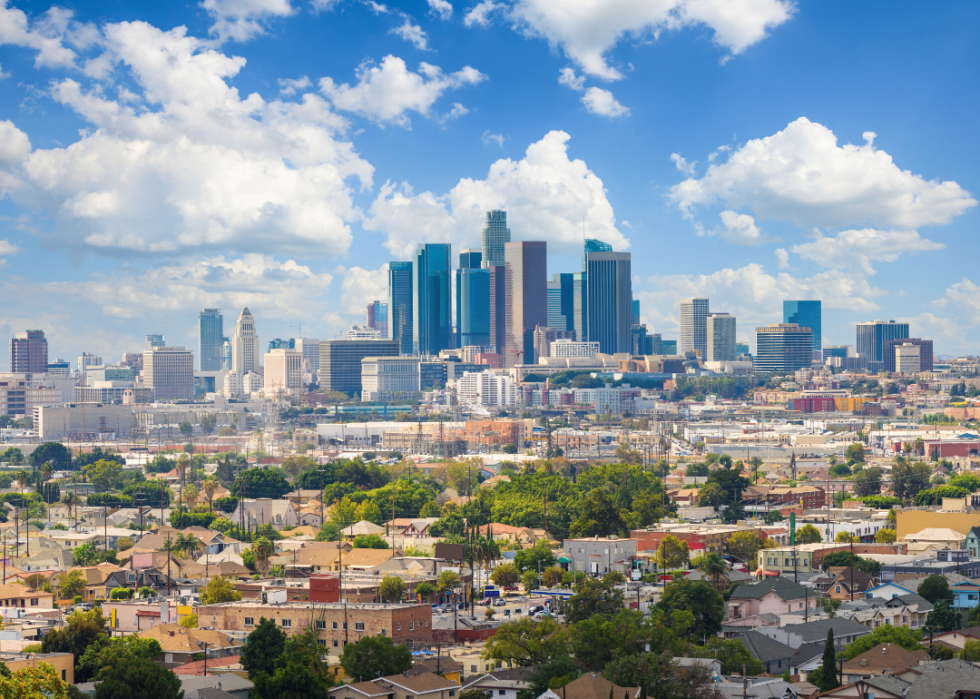
#46. California
- Respondents on Trump's handling of the response to COVID-19:
--- Approve or strongly approve: 34%
--- Neither approve nor disapprove: 19%
--- Disapprove or strongly disapprove: 47%
- Respondents on trusting Trump to handle COVID-19 response:
--- Trust Trump a lot: 21%
--- Don't trust Trump at all: 38%
- Party of respondents:
--- Republican: 30%
--- Democrat: 42%
--- Independent: 23%
--- Other: 4%
- State COVID-19 statistics as of May 1:
--- Positive cases: 50,442
--- Cumulative hospitalizations: data not available
--- Death toll: 2,073

#45. Michigan
- Respondents on Trump's handling of the response to COVID-19:
--- Approve or strongly approve: 36%
--- Neither approve nor disapprove: 15%
--- Disapprove or strongly disapprove: 49%
- Respondents on trusting Trump to handle COVID-19 response:
--- Trust Trump a lot: 20%
--- Don't trust Trump at all: 38%
- Party of respondents:
--- Republican: 28%
--- Democrat: 40%
--- Independent: 27%
--- Other: 5%
- State COVID-19 statistics as of May 1:
--- Positive cases: 42,356
--- Cumulative hospitalizations: data not available
--- Death toll: 3,866

#44. Connecticut
- Respondents on Trump's handling of the response to COVID-19:
--- Approve or strongly approve: 36%
--- Neither approve nor disapprove: 20%
--- Disapprove or strongly disapprove: 44%
- Respondents on trusting Trump to handle COVID-19 response:
--- Trust Trump a lot: 21%
--- Don't trust Trump at all: 35%
- Party of respondents:
--- Republican: 24%
--- Democrat: 36%
--- Independent: 36%
--- Other: 4%
- State COVID-19 statistics as of May 1:
--- Positive cases: 28,764
--- Cumulative hospitalizations: 7,758
--- Death toll: 2,339

#43. Rhode Island
- Respondents on Trump's handling of the response to COVID-19:
--- Approve or strongly approve: 37%
--- Neither approve nor disapprove: 21%
--- Disapprove or strongly disapprove: 42%
- Respondents on trusting Trump to handle COVID-19 response:
--- Trust Trump a lot: 23%
--- Don't trust Trump at all: 38%
- Party of respondents:
--- Republican: 20%
--- Democrat: 33%
--- Independent: 44%
--- Other: 4%
- State COVID-19 statistics as of May 1:
--- Positive cases: 8,962
--- Cumulative hospitalizations: 937
--- Death toll: 279

#42. Maryland
- Respondents on Trump's handling of the response to COVID-19:
--- Approve or strongly approve: 38%
--- Neither approve nor disapprove: 16%
--- Disapprove or strongly disapprove: 46%
- Respondents on trusting Trump to handle COVID-19 response:
--- Trust Trump a lot: 20%
--- Don't trust Trump at all: 40%
- Party of respondents:
--- Republican: 27%
--- Democrat: 47%
--- Independent: 24%
--- Other: 3%
- State COVID-19 statistics as of May 1:
--- Positive cases: 23,472
--- Cumulative hospitalizations: 4,718
--- Death toll: 1,192

#41. Massachusetts
- Respondents on Trump's handling of the response to COVID-19:
--- Approve or strongly approve: 38%
--- Neither approve nor disapprove: 17%
--- Disapprove or strongly disapprove: 46%
- Respondents on trusting Trump to handle COVID-19 response:
--- Trust Trump a lot: 26%
--- Don't trust Trump at all: 34%
- Party of respondents:
--- Republican: 20%
--- Democrat: 37%
--- Independent: 41%
--- Other: 2%
- State COVID-19 statistics as of May 1:
--- Positive cases: 64,311
--- Cumulative hospitalizations: 6,169
--- Death toll: 3,716

#40. Wisconsin
- Respondents on Trump's handling of the response to COVID-19:
--- Approve or strongly approve: 39%
--- Neither approve nor disapprove: 19%
--- Disapprove or strongly disapprove: 43%
- Respondents on trusting Trump to handle COVID-19 response:
--- Trust Trump a lot: 20%
--- Don't trust Trump at all: 34%
- Party of respondents:
--- Republican: 30%
--- Democrat: 33%
--- Independent: 29%
--- Other: 7%
- State COVID-19 statistics as of May 1:
--- Positive cases: 7,314
--- Cumulative hospitalizations: 1,544
--- Death toll: 327

#39. New Hampshire
- Respondents on Trump's handling of the response to COVID-19:
--- Approve or strongly approve: 39%
--- Neither approve nor disapprove: 16%
--- Disapprove or strongly disapprove: 45%
- Respondents on trusting Trump to handle COVID-19 response:
--- Trust Trump a lot: 22%
--- Don't trust Trump at all: 37%
- Party of respondents:
--- Republican: 20%
--- Democrat: 30%
--- Independent: 46%
--- Other: 4%
- State COVID-19 statistics as of May 1:
--- Positive cases: 2,146
--- Cumulative hospitalizations: 262
--- Death toll: 72
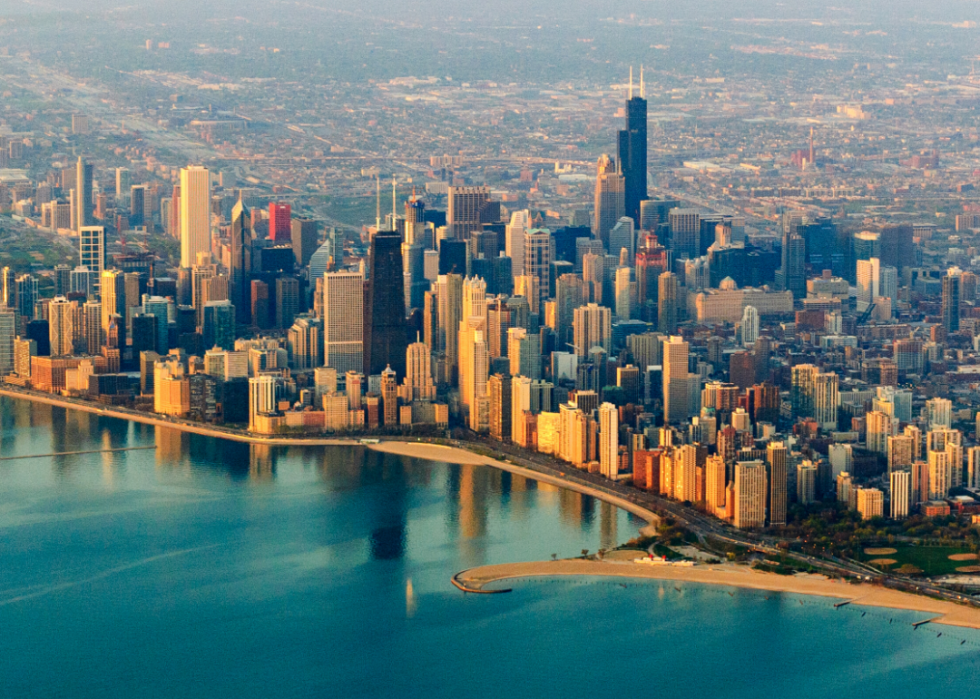
#38. Illinois
- Respondents on Trump's handling of the response to COVID-19:
--- Approve or strongly approve: 39%
--- Neither approve nor disapprove: 17%
--- Disapprove or strongly disapprove: 45%
- Respondents on trusting Trump to handle COVID-19 response:
--- Trust Trump a lot: 24%
--- Don't trust Trump at all: 36%
- Party of respondents:
--- Republican: 30%
--- Democrat: 41%
--- Independent: 24%
--- Other: 5%
- State COVID-19 statistics as of May 1:
--- Positive cases: 56,055
--- Cumulative hospitalizations: data not available
--- Death toll: 2,457

#37. Delaware
- Respondents on Trump's handling of the response to COVID-19:
--- Approve or strongly approve: 40%
--- Neither approve nor disapprove: 14%
--- Disapprove or strongly disapprove: 47%
- Respondents on trusting Trump to handle COVID-19 response:
--- Trust Trump a lot: 21%
--- Don't trust Trump at all: 38%
- Party of respondents:
--- Republican: 30%
--- Democrat: 38%
--- Independent: 28%
--- Other: 4%
- State COVID-19 statistics as of May 1:
--- Positive cases: 4,918
--- Cumulative hospitalizations: data not available
--- Death toll: 159

#36. Pennsylvania
- Respondents on Trump's handling of the response to COVID-19:
--- Approve or strongly approve: 40%
--- Neither approve nor disapprove: 17%
--- Disapprove or strongly disapprove: 43%
- Respondents on trusting Trump to handle COVID-19 response:
--- Trust Trump a lot: 22%
--- Don't trust Trump at all: 33%
- Party of respondents:
--- Republican: 34%
--- Democrat: 41%
--- Independent: 22%
--- Other: 2%
- State COVID-19 statistics as of May 1:
--- Positive cases: 46,971
--- Cumulative hospitalizations: data not available
--- Death toll: 2,354

#35. New Jersey
- Respondents on Trump's handling of the response to COVID-19:
--- Approve or strongly approve: 40%
--- Neither approve nor disapprove: 17%
--- Disapprove or strongly disapprove: 43%
- Respondents on trusting Trump to handle COVID-19 response:
--- Trust Trump a lot: 23%
--- Don't trust Trump at all: 33%
- Party of respondents:
--- Republican: 28%
--- Democrat: 41%
--- Independent: 27%
--- Other: 4%
- State COVID-19 statistics as of May 1:
--- Positive cases: 121,190
--- Cumulative hospitalizations: data not available
--- Death toll: 7,538

#34. New York
- Respondents on Trump's handling of the response to COVID-19:
--- Approve or strongly approve: 40%
--- Neither approve nor disapprove: 16%
--- Disapprove or strongly disapprove: 44%
- Respondents on trusting Trump to handle COVID-19 response:
--- Trust Trump a lot: 25%
--- Don't trust Trump at all: 35%
- Party of respondents:
--- Republican: 29%
--- Democrat: 44%
--- Independent: 23%
--- Other: 4%
- State COVID-19 statistics as of May 1:
--- Positive cases: 308,314
--- Cumulative hospitalizations: 67,180
--- Death toll: 18,610

#33. New Mexico
- Respondents on Trump's handling of the response to COVID-19:
--- Approve or strongly approve: 41%
--- Neither approve nor disapprove: 18%
--- Disapprove or strongly disapprove: 40%
- Respondents on trusting Trump to handle COVID-19 response:
--- Trust Trump a lot: 27%
--- Don't trust Trump at all: 36%
- Party of respondents:
--- Republican: 30%
--- Democrat: 30%
--- Independent: 34%
--- Other: 6%
- State COVID-19 statistics as of May 1:
--- Positive cases: 3,411
--- Cumulative hospitalizations: 536
--- Death toll: 123

#32. Nevada
- Respondents on Trump's handling of the response to COVID-19:
--- Approve or strongly approve: 41%
--- Neither approve nor disapprove: 18%
--- Disapprove or strongly disapprove: 41%
- Respondents on trusting Trump to handle COVID-19 response:
--- Trust Trump a lot: 28%
--- Don't trust Trump at all: 36%
- Party of respondents:
--- Republican: 22%
--- Democrat: 43%
--- Independent: 30%
--- Other: 4%
- State COVID-19 statistics as of May 1:
--- Positive cases: 5,227
--- Cumulative hospitalizations: data not available
--- Death toll: 243

#31. Colorado
- Respondents on Trump's handling of the response to COVID-19:
--- Approve or strongly approve: 42%
--- Neither approve nor disapprove: 15%
--- Disapprove or strongly disapprove: 43%
- Respondents on trusting Trump to handle COVID-19 response:
--- Trust Trump a lot: 26%
--- Don't trust Trump at all: 36%
- Party of respondents:
--- Republican: 32%
--- Democrat: 28%
--- Independent: 36%
--- Other: 4%
- State COVID-19 statistics as of May 1:
--- Positive cases: 15,284
--- Cumulative hospitalizations: 2,697
--- Death toll: 777

#30. Minnesota
- Respondents on Trump's handling of the response to COVID-19:
--- Approve or strongly approve: 42%
--- Neither approve nor disapprove: 19%
--- Disapprove or strongly disapprove: 38%
- Respondents on trusting Trump to handle COVID-19 response:
--- Trust Trump a lot: 27%
--- Don't trust Trump at all: 28%
- Party of respondents:
--- Republican: 33%
--- Democrat: 33%
--- Independent: 27%
--- Other: 7%
- State COVID-19 statistics as of May 1:
--- Positive cases: 5,730
--- Cumulative hospitalizations: 1,096
--- Death toll: 371
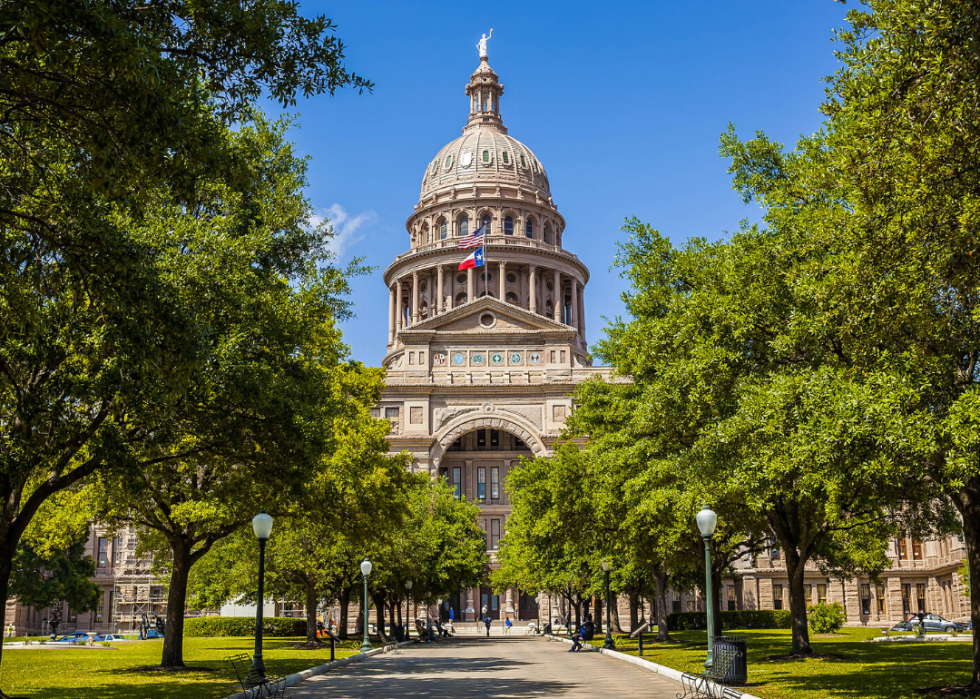
#29. Texas
- Respondents on Trump's handling of the response to COVID-19:
--- Approve or strongly approve: 44%
--- Neither approve nor disapprove: 20%
--- Disapprove or strongly disapprove: 35%
- Respondents on trusting Trump to handle COVID-19 response:
--- Trust Trump a lot: 28%
--- Don't trust Trump at all: 29%
- Party of respondents:
--- Republican: 33%
--- Democrat: 37%
--- Independent: 24%
--- Other: 6%
- State COVID-19 statistics as of May 1:
--- Positive cases: 29,229
--- Cumulative hospitalizations: data not available
--- Death toll: 816

#28. Virginia
- Respondents on Trump's handling of the response to COVID-19:
--- Approve or strongly approve: 44%
--- Neither approve nor disapprove: 15%
--- Disapprove or strongly disapprove: 40%
- Respondents on trusting Trump to handle COVID-19 response:
--- Trust Trump a lot: 29%
--- Don't trust Trump at all: 33%
- Party of respondents:
--- Republican: 30%
--- Democrat: 36%
--- Independent: 29%
--- Other: 4%
- State COVID-19 statistics as of May 1:
--- Positive cases: 16,901
--- Cumulative hospitalizations: 3,654
--- Death toll: 581
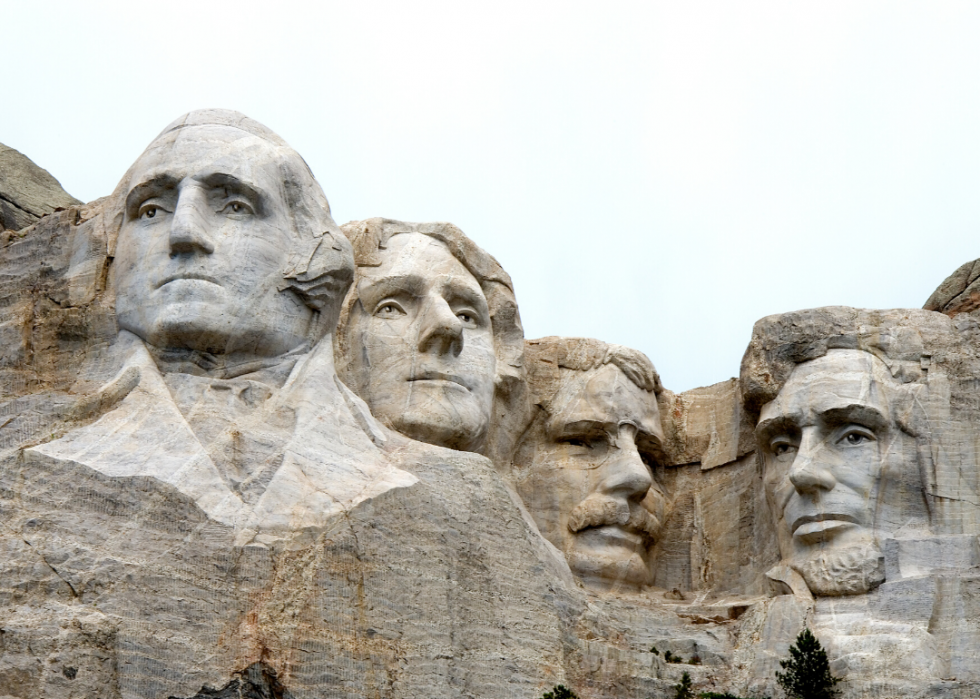
#27. South Dakota
- Respondents on Trump's handling of the response to COVID-19:
--- Approve or strongly approve: 45%
--- Neither approve nor disapprove: 23%
--- Disapprove or strongly disapprove: 32%
- Respondents on trusting Trump to handle COVID-19 response:
--- Trust Trump a lot: 21%
--- Don't trust Trump at all: 19%
- Party of respondents:
--- Republican: 38%
--- Democrat: 24%
--- Independent: 33%
--- Other: 6%
- State COVID-19 statistics as of May 1:
--- Positive cases: 2,525
--- Cumulative hospitalizations: 179
--- Death toll: 21

#25. Maine (tie)
- Respondents on Trump's handling of the response to COVID-19:
--- Approve or strongly approve: 45%
--- Neither approve nor disapprove: 16%
--- Disapprove or strongly disapprove: 39%
- Respondents on trusting Trump to handle COVID-19 response:
--- Trust Trump a lot: 27%
--- Don't trust Trump at all: 30%
- Party of respondents:
--- Republican: 29%
--- Democrat: 28%
--- Independent: 38%
--- Other: 4%
- State COVID-19 statistics as of May 1:
--- Positive cases: 1,123
--- Cumulative hospitalizations: 177
--- Death toll: 55

#25. Arizona (tie)
- Respondents on Trump's handling of the response to COVID-19:
--- Approve or strongly approve: 45%
--- Neither approve nor disapprove: 17%
--- Disapprove or strongly disapprove: 39%
- Respondents on trusting Trump to handle COVID-19 response:
--- Trust Trump a lot: 27%
--- Don't trust Trump at all: 32%
- Party of respondents:
--- Republican: 36%
--- Democrat: 34%
--- Independent: 28%
--- Other: 2%
- State COVID-19 statistics as of May 1:
--- Positive cases: 7,962
--- Cumulative hospitalizations: 1,203
--- Death toll: 330
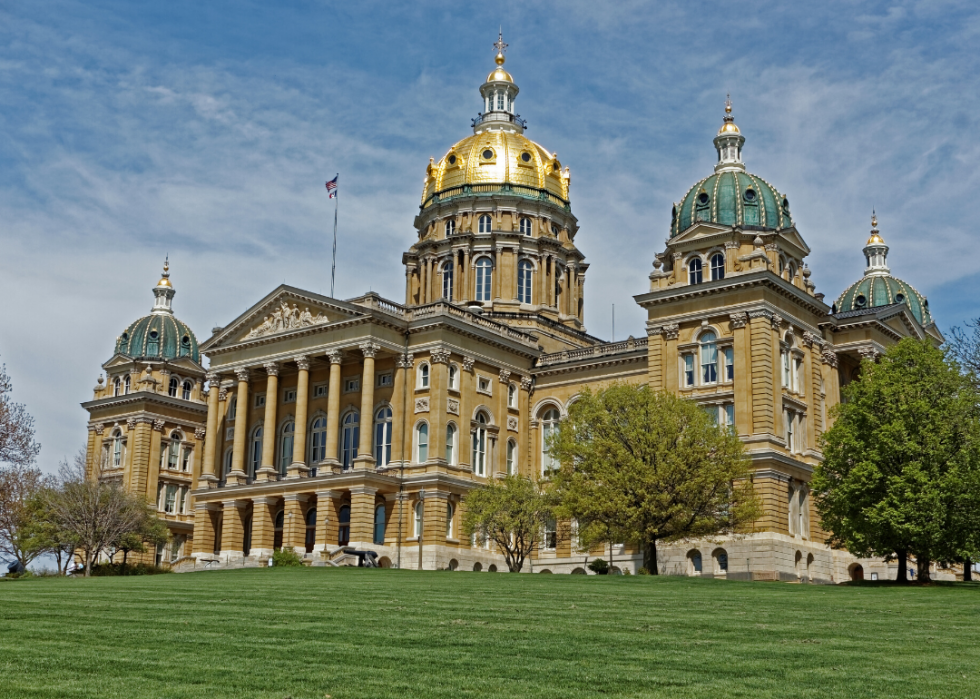
#24. Iowa
- Respondents on Trump's handling of the response to COVID-19:
--- Approve or strongly approve: 46%
--- Neither approve nor disapprove: 18%
--- Disapprove or strongly disapprove: 37%
- Respondents on trusting Trump to handle COVID-19 response:
--- Trust Trump a lot: 23%
--- Don't trust Trump at all: 32%
- Party of respondents:
--- Republican: 29%
--- Democrat: 32%
--- Independent: 36%
--- Other: 4%
- State COVID-19 statistics as of May 1:
--- Positive cases: 7,884
--- Cumulative hospitalizations: data not available
--- Death toll: 170

#23. South Carolina
- Respondents on Trump's handling of the response to COVID-19:
--- Approve or strongly approve: 47%
--- Neither approve nor disapprove: 17%
--- Disapprove or strongly disapprove: 37%
- Respondents on trusting Trump to handle COVID-19 response:
--- Trust Trump a lot: 27%
--- Don't trust Trump at all: 32%
- Party of respondents:
--- Republican: 33%
--- Democrat: 32%
--- Independent: 30%
--- Other: 4%
- State COVID-19 statistics as of May 1:
--- Positive cases: 6,258
--- Cumulative hospitalizations: 1,110
--- Death toll: 256

#22. North Carolina
- Respondents on Trump's handling of the response to COVID-19:
--- Approve or strongly approve: 47%
--- Neither approve nor disapprove: 18%
--- Disapprove or strongly disapprove: 35%
- Respondents on trusting Trump to handle COVID-19 response:
--- Trust Trump a lot: 28%
--- Don't trust Trump at all: 30%
- Party of respondents:
--- Republican: 34%
--- Democrat: 35%
--- Independent: 28%
--- Other: 4%
- State COVID-19 statistics as of May 1:
--- Positive cases: 10,923
--- Cumulative hospitalizations: data not available
--- Death toll: 399
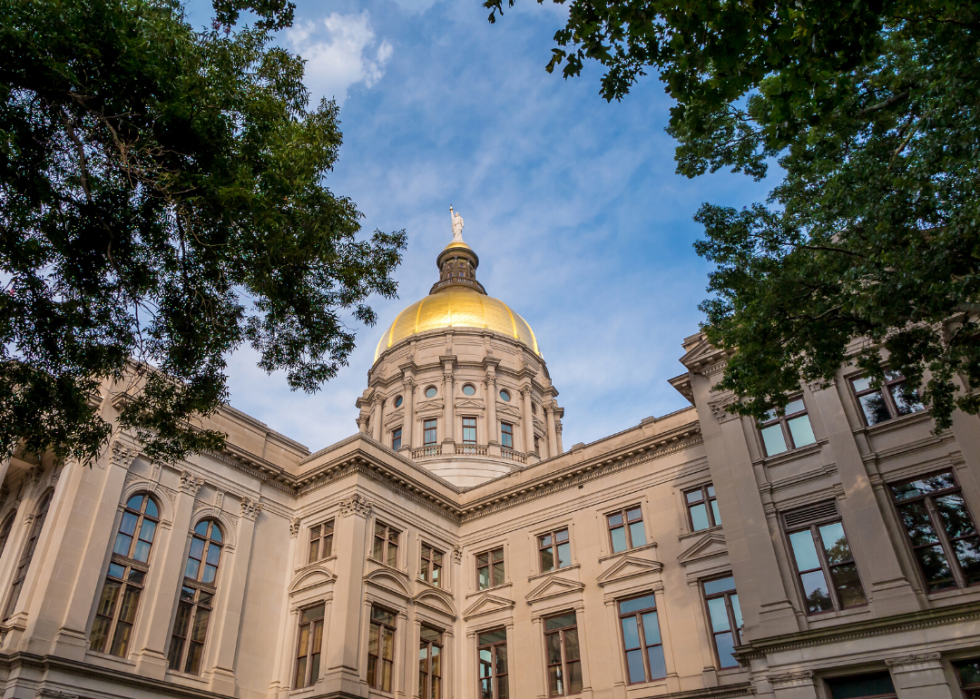
#21. Georgia
- Respondents on Trump's handling of the response to COVID-19:
--- Approve or strongly approve: 47%
--- Neither approve nor disapprove: 17%
--- Disapprove or strongly disapprove: 35%
- Respondents on trusting Trump to handle COVID-19 response:
--- Trust Trump a lot: 29%
--- Don't trust Trump at all: 29%
- Party of respondents:
--- Republican: 34%
--- Democrat: 38%
--- Independent: 24%
--- Other: 4%
- State COVID-19 statistics as of May 1:
--- Positive cases: 27,270
--- Cumulative hospitalizations: 5,269
--- Death toll: 1,154

#19. Utah (tie)
- Respondents on Trump's handling of the response to COVID-19:
--- Approve or strongly approve: 47%
--- Neither approve nor disapprove: 19%
--- Disapprove or strongly disapprove: 35%
- Respondents on trusting Trump to handle COVID-19 response:
--- Trust Trump a lot: 30%
--- Don't trust Trump at all: 22%
- Party of respondents:
--- Republican: 43%
--- Democrat: 26%
--- Independent: 24%
--- Other: 7%
- State COVID-19 statistics as of May 1:
--- Positive cases: 4,828
--- Cumulative hospitalizations: 403
--- Death toll: 46
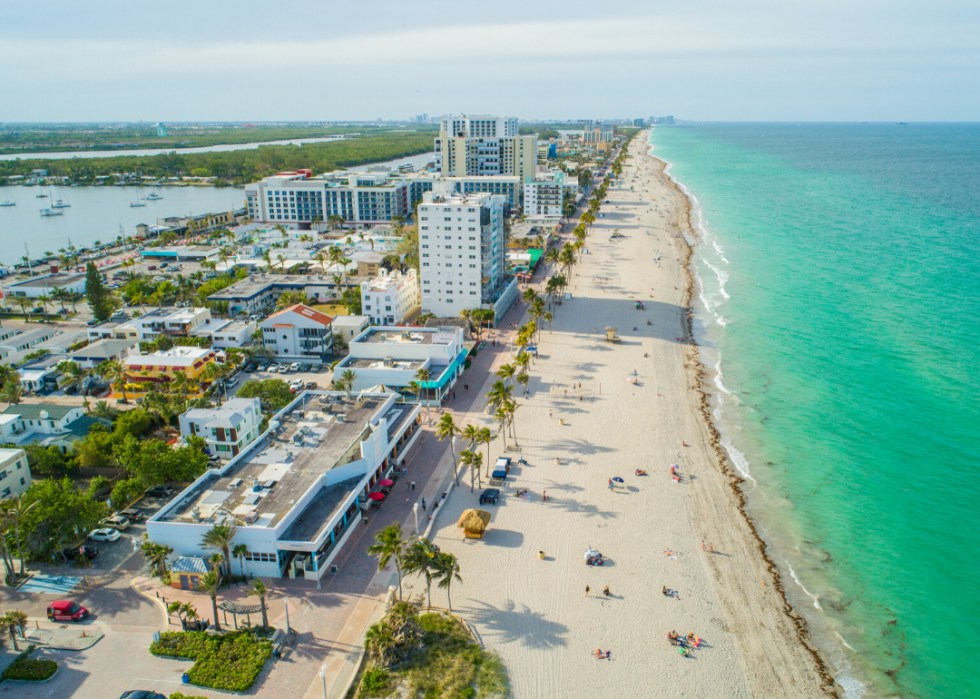
#19. Florida (tie)
- Respondents on Trump's handling of the response to COVID-19:
--- Approve or strongly approve: 47%
--- Neither approve nor disapprove: 15%
--- Disapprove or strongly disapprove: 37%
- Respondents on trusting Trump to handle COVID-19 response:
--- Trust Trump a lot: 30%
--- Don't trust Trump at all: 30%
- Party of respondents:
--- Republican: 34%
--- Democrat: 38%
--- Independent: 25%
--- Other: 3%
- State COVID-19 statistics as of May 1:
--- Positive cases: 34,728
--- Cumulative hospitalizations: 5,795
--- Death toll: 1,314

#18. Kansas
- Respondents on Trump's handling of the response to COVID-19:
--- Approve or strongly approve: 48%
--- Neither approve nor disapprove: 16%
--- Disapprove or strongly disapprove: 35%
- Respondents on trusting Trump to handle COVID-19 response:
--- Trust Trump a lot: 25%
--- Don't trust Trump at all: 28%
- Party of respondents:
--- Republican: 32%
--- Democrat: 35%
--- Independent: 28%
--- Other: 6%
- State COVID-19 statistics as of May 1:
--- Positive cases: 4,449
--- Cumulative hospitalizations: 534
--- Death toll: 130

#17. Missouri
- Respondents on Trump's handling of the response to COVID-19:
--- Approve or strongly approve: 48%
--- Neither approve nor disapprove: 16%
--- Disapprove or strongly disapprove: 35%
- Respondents on trusting Trump to handle COVID-19 response:
--- Trust Trump a lot: 27%
--- Don't trust Trump at all: 29%
- Party of respondents:
--- Republican: 37%
--- Democrat: 31%
--- Independent: 28%
--- Other: 3%
- State COVID-19 statistics as of May 1:
--- Positive cases: 7,835
--- Cumulative hospitalizations: data not available
--- Death toll: 337

#16. Mississippi
- Respondents on Trump's handling of the response to COVID-19:
--- Approve or strongly approve: 48%
--- Neither approve nor disapprove: 20%
--- Disapprove or strongly disapprove: 32%
- Respondents on trusting Trump to handle COVID-19 response:
--- Trust Trump a lot: 32%
--- Don't trust Trump at all: 31%
- Party of respondents:
--- Republican: 40%
--- Democrat: 32%
--- Independent: 23%
--- Other: 5%
- State COVID-19 statistics as of May 1:
--- Positive cases: 7,212
--- Cumulative hospitalizations: 1,226
--- Death toll: 281

#15. Alaska
- Respondents on Trump's handling of the response to COVID-19:
--- Approve or strongly approve: 50%
--- Neither approve nor disapprove: 21%
--- Disapprove or strongly disapprove: 29%
- Respondents on trusting Trump to handle COVID-19 response:
--- Trust Trump a lot: 28%
--- Don't trust Trump at all: 25%
- Party of respondents:
--- Republican: 29%
--- Democrat: 16%
--- Independent: 45%
--- Other: 10%
- State COVID-19 statistics as of May 1:
--- Positive cases: 364
--- Cumulative hospitalizations: data not available
--- Death toll: 9

#14. Louisiana
- Respondents on Trump's handling of the response to COVID-19:
--- Approve or strongly approve: 50%
--- Neither approve nor disapprove: 17%
--- Disapprove or strongly disapprove: 33%
- Respondents on trusting Trump to handle COVID-19 response:
--- Trust Trump a lot: 31%
--- Don't trust Trump at all: 29%
- Party of respondents:
--- Republican: 37%
--- Democrat: 32%
--- Independent: 26%
--- Other: 5%
- State COVID-19 statistics as of May 1:
--- Positive cases: 28,711
--- Cumulative hospitalizations: data not available
--- Death toll: 1,927

#13. Montana
- Respondents on Trump's handling of the response to COVID-19:
--- Approve or strongly approve: 50%
--- Neither approve nor disapprove: 20%
--- Disapprove or strongly disapprove: 29%
- Respondents on trusting Trump to handle COVID-19 response:
--- Trust Trump a lot: 34%
--- Don't trust Trump at all: 31%
- Party of respondents:
--- Republican: 40%
--- Democrat: 25%
--- Independent: 27%
--- Other: 9%
- State COVID-19 statistics as of May 1:
--- Positive cases: 453
--- Cumulative hospitalizations: 61
--- Death toll: 16

#12. Oklahoma
- Respondents on Trump's handling of the response to COVID-19:
--- Approve or strongly approve: 51%
--- Neither approve nor disapprove: 16%
--- Disapprove or strongly disapprove: 34%
- Respondents on trusting Trump to handle COVID-19 response:
--- Trust Trump a lot: 28%
--- Don't trust Trump at all: 31%
- Party of respondents:
--- Republican: 40%
--- Democrat: 30%
--- Independent: 25%
--- Other: 5%
- State COVID-19 statistics as of May 1:
--- Positive cases: 3,748
--- Cumulative hospitalizations: 715
--- Death toll: 230

#11. Ohio
- Respondents on Trump's handling of the response to COVID-19:
--- Approve or strongly approve: 51%
--- Neither approve nor disapprove: 13%
--- Disapprove or strongly disapprove: 36%
- Respondents on trusting Trump to handle COVID-19 response:
--- Trust Trump a lot: 29%
--- Don't trust Trump at all: 28%
- Party of respondents:
--- Republican: 35%
--- Democrat: 33%
--- Independent: 28%
--- Other: 4%
- State COVID-19 statistics as of May 1:
--- Positive cases: 18,743
--- Cumulative hospitalizations: 3,634
--- Death toll: 1,002
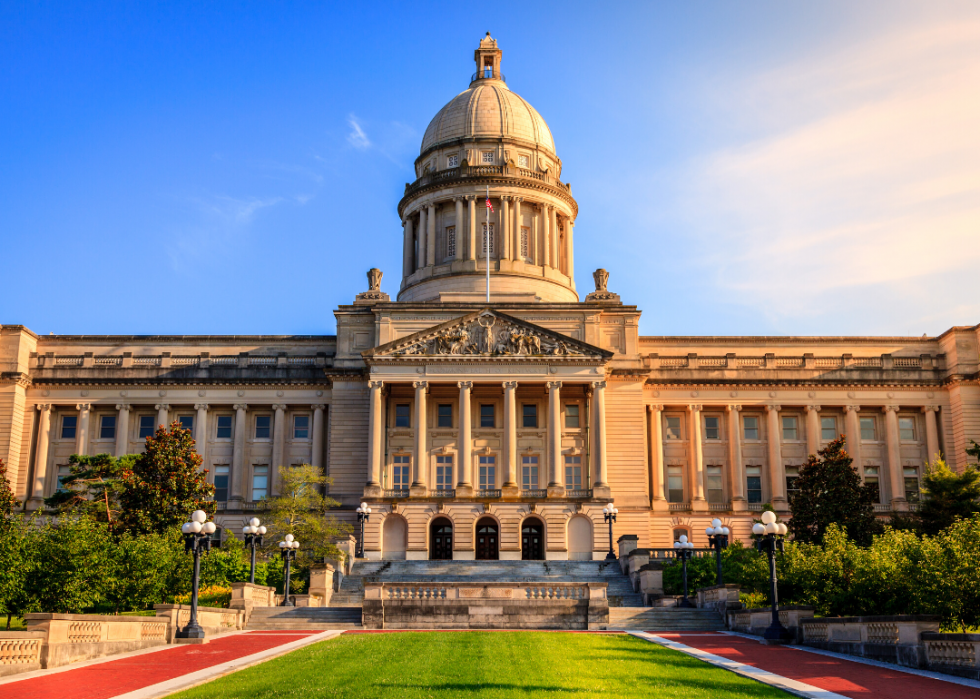
#10. Kentucky
- Respondents on Trump's handling of the response to COVID-19:
--- Approve or strongly approve: 51%
--- Neither approve nor disapprove: 18%
--- Disapprove or strongly disapprove: 31%
- Respondents on trusting Trump to handle COVID-19 response:
--- Trust Trump a lot: 32%
--- Don't trust Trump at all: 27%
- Party of respondents:
--- Republican: 39%
--- Democrat: 33%
--- Independent: 24%
--- Other: 5%
- State COVID-19 statistics as of May 1:
--- Positive cases: 4,708
--- Cumulative hospitalizations: 1,375
--- Death toll: 240

#9. Tennessee
- Respondents on Trump's handling of the response to COVID-19:
--- Approve or strongly approve: 52%
--- Neither approve nor disapprove: 17%
--- Disapprove or strongly disapprove: 31%
- Respondents on trusting Trump to handle COVID-19 response:
--- Trust Trump a lot: 27%
--- Don't trust Trump at all: 27%
- Party of respondents:
--- Republican: 41%
--- Democrat: 30%
--- Independent: 24%
--- Other: 4%
- State COVID-19 statistics as of May 1:
--- Positive cases: 11,891
--- Cumulative hospitalizations: 1,113
--- Death toll: 204

#8. Indiana
- Respondents on Trump's handling of the response to COVID-19:
--- Approve or strongly approve: 52%
--- Neither approve nor disapprove: 14%
--- Disapprove or strongly disapprove: 33%
- Respondents on trusting Trump to handle COVID-19 response:
--- Trust Trump a lot: 31%
--- Don't trust Trump at all: 26%
- Party of respondents:
--- Republican: 36%
--- Democrat: 32%
--- Independent: 28%
--- Other: 4%
- State COVID-19 statistics as of May 1:
--- Positive cases: 18,630
--- Cumulative hospitalizations: data not available
--- Death toll: 1,175
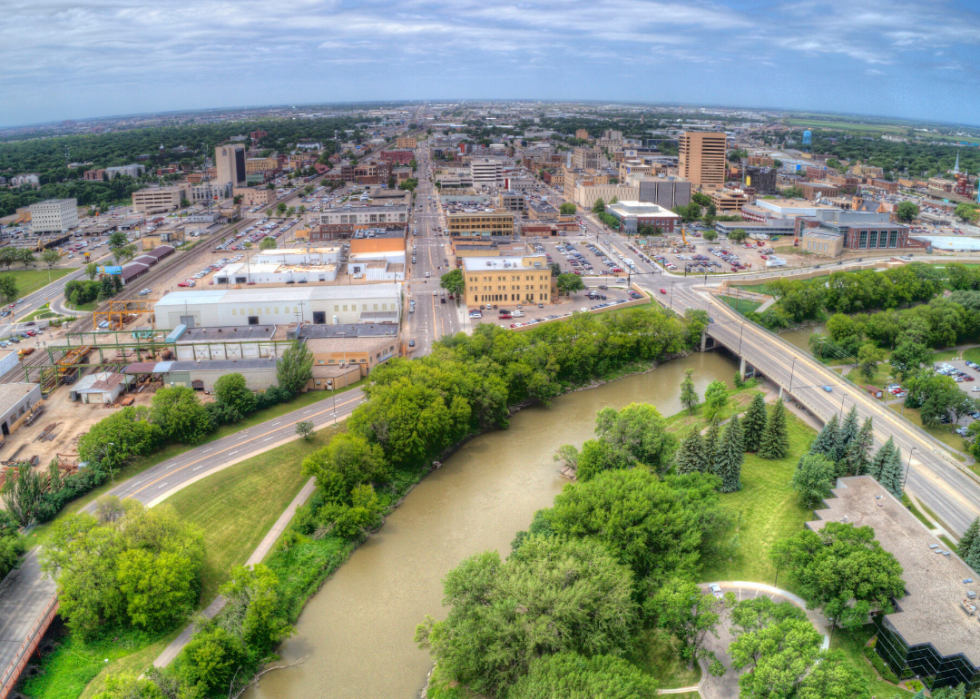
#7. North Dakota
- Respondents on Trump's handling of the response to COVID-19:
--- Approve or strongly approve: 53%
--- Neither approve nor disapprove: 11%
--- Disapprove or strongly disapprove: 36%
- Respondents on trusting Trump to handle COVID-19 response:
--- Trust Trump a lot: 26%
--- Don't trust Trump at all: 27%
- Party of respondents:
--- Republican: 38%
--- Democrat: 15%
--- Independent: 38%
--- Other: 9%
- State COVID-19 statistics as of May 1:
--- Positive cases: 1,107
--- Cumulative hospitalizations: 86
--- Death toll: 23

#6. Arkansas
- Respondents on Trump's handling of the response to COVID-19:
--- Approve or strongly approve: 53%
--- Neither approve nor disapprove: 16%
--- Disapprove or strongly disapprove: 31%
- Respondents on trusting Trump to handle COVID-19 response:
--- Trust Trump a lot: 32%
--- Don't trust Trump at all: 26%
- Party of respondents:
--- Republican: 34%
--- Democrat: 30%
--- Independent: 30%
--- Other: 7%
- State COVID-19 statistics as of May 1:
--- Positive cases: 3,321
--- Cumulative hospitalizations: 414
--- Death toll: 64
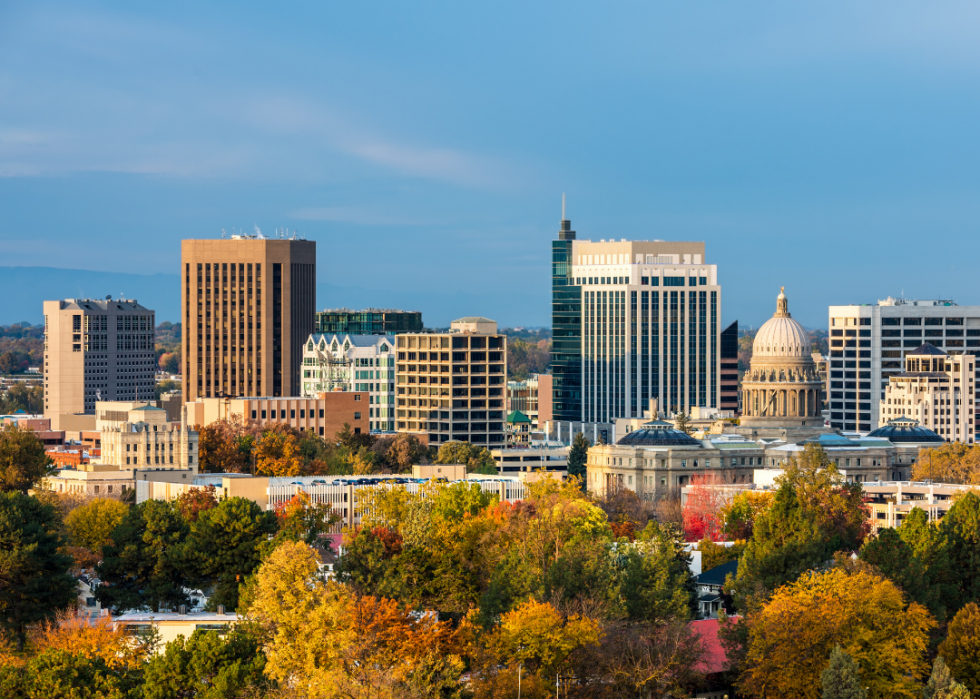
#5. Idaho
- Respondents on Trump's handling of the response to COVID-19:
--- Approve or strongly approve: 55%
--- Neither approve nor disapprove: 15%
--- Disapprove or strongly disapprove: 30%
- Respondents on trusting Trump to handle COVID-19 response:
--- Trust Trump a lot: 28%
--- Don't trust Trump at all: 28%
- Party of respondents:
--- Republican: 35%
--- Democrat: 20%
--- Independent: 37%
--- Other: 8%
- State COVID-19 statistics as of May 1:
--- Positive cases: 2,015
--- Cumulative hospitalizations: 178
--- Death toll: 63

#4. Nebraska
- Respondents on Trump's handling of the response to COVID-19:
--- Approve or strongly approve: 55%
--- Neither approve nor disapprove: 18%
--- Disapprove or strongly disapprove: 27%
- Respondents on trusting Trump to handle COVID-19 response:
--- Trust Trump a lot: 34%
--- Don't trust Trump at all: 22%
- Party of respondents:
--- Republican: 42%
--- Democrat: 26%
--- Independent: 26%
--- Other: 6%
- State COVID-19 statistics as of May 1:
--- Positive cases: 4,281
--- Cumulative hospitalizations: data not available
--- Death toll: 70

#3. Alabama
- Respondents on Trump's handling of the response to COVID-19:
--- Approve or strongly approve: 55%
--- Neither approve nor disapprove: 17%
--- Disapprove or strongly disapprove: 29%
- Respondents on trusting Trump to handle COVID-19 response:
--- Trust Trump a lot: 36%
--- Don't trust Trump at all: 24%
- Party of respondents:
--- Republican: 43%
--- Democrat: 28%
--- Independent: 27%
--- Other: 2%
- State COVID-19 statistics as of May 1:
--- Positive cases: 7,158
--- Cumulative hospitalizations: 1,008
--- Death toll: 279

#2. West Virginia
- Respondents on Trump's handling of the response to COVID-19:
--- Approve or strongly approve: 57%
--- Neither approve nor disapprove: 18%
--- Disapprove or strongly disapprove: 24%
- Respondents on trusting Trump to handle COVID-19 response:
--- Trust Trump a lot: 36%
--- Don't trust Trump at all: 22%
- Party of respondents:
--- Republican: 34%
--- Democrat: 26%
--- Independent: 36%
--- Other: 3%
- State COVID-19 statistics as of May 1:
--- Positive cases: 1,136
--- Cumulative hospitalizations: data not available
--- Death toll: 46

#1. Wyoming
- Respondents on Trump's handling of the response to COVID-19:
--- Approve or strongly approve: 59%
--- Neither approve nor disapprove: 21%
--- Disapprove or strongly disapprove: 20%
- Respondents on trusting Trump to handle COVID-19 response:
--- Trust Trump a lot: 35%
--- Don't trust Trump at all: 18%
- Party of respondents:
--- Republican: 45%
--- Democrat: 17%
--- Independent: 30%
--- Other: 8%
- State COVID-19 statistics as of May 1:
--- Positive cases: 559
--- Cumulative hospitalizations: 56
--- Death toll: 7



